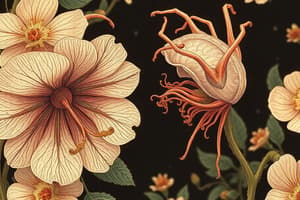Podcast
Questions and Answers
How does the process of vegetative propagation contribute to both the advantages and disadvantages in agricultural practices?
How does the process of vegetative propagation contribute to both the advantages and disadvantages in agricultural practices?
Vegetative propagation allows for the rapid and uniform production of crops with desirable traits, ensuring genetic consistency. However, it can also lead to a lack of genetic diversity, making crops more susceptible to diseases and environmental changes.
Explain how the alteration of the photoperiod (duration of light and dark) could affect the timing of flower production in long-day and short-day plants.
Explain how the alteration of the photoperiod (duration of light and dark) could affect the timing of flower production in long-day and short-day plants.
In long-day plants, extended light exposure promotes flowering by triggering the production of specific hormones. Conversely, short-day plants require longer periods of darkness for flowering; thus, increased light exposure can inhibit it.
Describe the significance of double fertilization in angiosperms and explain what products are formed from this process.
Describe the significance of double fertilization in angiosperms and explain what products are formed from this process.
Double fertilization ensures that the endosperm, which nourishes the developing embryo, only develops in fertilized ovules. It results in the formation of a zygote (future embryo) and endosperm (nutritive tissue).
Contrast the strategies organisms use to reproduce asexually in stable versus unstable environments. Provide an example for each case.
Contrast the strategies organisms use to reproduce asexually in stable versus unstable environments. Provide an example for each case.
Explain how external and internal fertilization methods correlate with the number of eggs produced and the level of parental care typically provided.
Explain how external and internal fertilization methods correlate with the number of eggs produced and the level of parental care typically provided.
How do hormonal birth control methods prevent pregnancy, and what are the primary mechanisms involved?
How do hormonal birth control methods prevent pregnancy, and what are the primary mechanisms involved?
How does the timing of puberty affect reproductive health and potential risks, particularly in the context of early or delayed onset?
How does the timing of puberty affect reproductive health and potential risks, particularly in the context of early or delayed onset?
Describe the roles of both mitosis and meiosis in sexual reproduction, and explain where each process occurs.
Describe the roles of both mitosis and meiosis in sexual reproduction, and explain where each process occurs.
Explain how the structure of the flower facilitates both self-pollination and cross-pollination, and detail structural modifications that promote one over the other.
Explain how the structure of the flower facilitates both self-pollination and cross-pollination, and detail structural modifications that promote one over the other.
In the context of reproduction, what are the differences between artificial insemination (AI) and in vitro fertilization (IVF), and for what types of infertility issues might each be recommended?
In the context of reproduction, what are the differences between artificial insemination (AI) and in vitro fertilization (IVF), and for what types of infertility issues might each be recommended?
Flashcards
What is Reproduction?
What is Reproduction?
Production of new organisms to continue species.
Asexual Reproduction
Asexual Reproduction
Involves one parent; offspring are genetically identical.
Cloning
Cloning
Offspring are identical copies of a single parent
Fission
Fission
Signup and view all the flashcards
Budding
Budding
Signup and view all the flashcards
Fragmentation
Fragmentation
Signup and view all the flashcards
Regeneration
Regeneration
Signup and view all the flashcards
Vegetative Propagation
Vegetative Propagation
Signup and view all the flashcards
Sexual Reproduction
Sexual Reproduction
Signup and view all the flashcards
Gametogenesis
Gametogenesis
Signup and view all the flashcards
Study Notes
- Reproduction is a fundamental characteristic of all living organisms
- It ensures the continuity of species by generating new individuals
Types of Reproduction
- Asexual reproduction involves a single parent and produces offspring that are genetically identical to the parent and to each other
- Sexual reproduction involves two parents, and the offspring are genetically different from each other and from the parents
Asexual Reproduction
- Offspring are identical copies of a single parent
- Cloning describes this process
- This process is common in unicellular organisms, plants, and some animals
Methods of Asexual Reproduction
Fission
- A single cell divides into two identical daughter cells
- Binary fission occurs in bacteria and amoeba
- Multiple fission occurs in Plasmodium
Budding
- A new organism develops as an outgrowth or bud from the parent's body
- Common in yeast and Hydra
Fragmentation
- The parent organism breaks into fragments, with each fragment developing into a new individual
- Seen in some algae (e.g., Spirogyra) and starfish
Regeneration
- The ability to regrow lost or damaged body parts
- Highly developed in planarians and starfish
Spore Formation
- Parent plants produce spores that germinate into new individuals under favorable conditions
- Common in fungi and bacteria
Vegetative Propagation
- New plants are produced from vegetative parts such as stems, roots, and leaves
- Examples include runners in strawberries, rhizomes in ginger, tubers in potatoes, and bulbs in onions
Sexual Reproduction
- Involves the fusion of two gametes (sex cells) from two parents
- Results in offspring with genetic variation
- Gametes are formed by meiosis
Process of Sexual Reproduction
Gametogenesis
- Formation of gametes
- Male gametes are called sperm, and female gametes are called eggs or ova
- Meiosis halves the chromosome number in gametes
Fertilization
- Fusion of male and female gametes to form a zygote
- Restores the diploid number of chromosomes
Zygote Formation
- The zygote undergoes repeated cell divisions (mitosis) to form an embryo
- The embryo develops into a new individual
Advantages of Sexual Reproduction
- Introduces genetic variation, which is crucial for adaptation and evolution
- Promotes survival in changing environments
- Eliminates harmful mutations through genetic recombination
Reproduction in Organisms
Reproduction in Bacteria
- Primarily reproduces asexually through binary fission
- Under unfavorable conditions, some bacteria can form endospores, which are highly resistant structures
Reproduction in Protists
- Reproduce asexually through binary fission, multiple fission, or budding
- Some protists undergo sexual reproduction through conjugation
Reproduction in Fungi
- Reproduce asexually through spore formation, budding, or fragmentation
- Some fungi undergo sexual reproduction through the fusion of hyphae
Reproduction in Plants
- Exhibit both asexual (vegetative propagation) and sexual reproduction
- Sexual reproduction involves the formation of seeds and fruits
Reproduction in Animals
- Primarily reproduce sexually
- Some animals can reproduce asexually through fragmentation (e.g., starfish) or parthenogenesis (development of an unfertilized egg, e.g., some insects)
Sexual Reproduction in Flowering Plants
Structures
- Flowers are the reproductive structures in angiosperms (flowering plants)
- The flower consists of sepals, petals, stamen (male reproductive organ), and pistil (female reproductive organ)
Pollination
- Transfer of pollen grains from the anther to the stigma
- Can be self-pollination (within the same flower) or cross-pollination (between different flowers)
- Agents of pollination include wind, water, insects, and animals
Fertilization in Plants
- After pollination, the pollen grain germinates on the stigma and grows a pollen tube down to the ovary
- The pollen tube carries the male gametes to the ovule
- Double fertilization occurs, where one male gamete fuses with the egg to form the zygote, and the other fuses with the polar nuclei to form the endosperm
Seed and Fruit Formation
- The zygote develops into an embryo, and the ovule develops into a seed
- The ovary develops into a fruit, which protects the seed and aids in its dispersal
Sexual Reproduction in Humans
Reproductive Organs
- Male reproductive system includes testes, vas deferens, seminal vesicles, prostate gland, and penis
- Female reproductive system includes ovaries, fallopian tubes, uterus, and vagina
Gametogenesis in Humans
- Spermatogenesis: Formation of sperm in the testes
- Oogenesis: Formation of eggs in the ovaries
Menstrual Cycle
- A recurring monthly cycle in females involving changes in the uterus and ovaries
- Regulated by hormones (estrogen and progesterone)
- Prepares the uterus for implantation of a fertilized egg
Fertilization in Humans
- Occurs in the fallopian tube
- The sperm fuses with the egg to form a zygote
Embryonic Development
- The zygote undergoes cleavage (rapid cell division) to form a blastocyst
- The blastocyst implants in the uterine wall
- The embryo develops through gastrulation and organogenesis
Gestation
- Pregnancy period, lasting about 9 months (40 weeks) in humans
- The fetus develops in the uterus, nourished by the placenta
Parturition
- Childbirth
- Involves a series of contractions to expel the fetus from the uterus
Reproductive Health
- Maintaining reproductive health is essential for individuals and society
- Includes preventing sexually transmitted infections (STIs) and unplanned pregnancies
Birth Control Methods
- Various methods are available to prevent pregnancy
- Barrier methods (condoms, diaphragms), hormonal methods (oral contraceptives, implants), intrauterine devices (IUDs), and surgical methods (vasectomy, tubal ligation)
Assisted Reproductive Technologies (ART)
- Techniques used to help infertile couples conceive
- In vitro fertilization (IVF), gamete intrafallopian transfer (GIFT), and artificial insemination (AI)
Studying That Suits You
Use AI to generate personalized quizzes and flashcards to suit your learning preferences.




